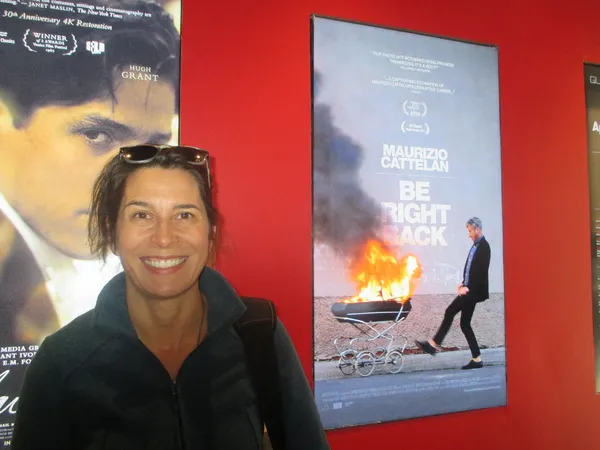 |
| Maurizio Cattelan: Be Right Back director Maura Axelrod at the Quad Cinema Photo: Anne-Katrin Titze |
On the morning before the reopening of the Quad Cinema in New York, where two impressive features - Terence Davies' A Quiet Passion and Katell Quillévéré's Heal The Living (Réparer Les Vivants) - are now screening, Maura Axelrod, the director of Maurizio Cattelan: Be Right Back, met with me at Foragers in Chelsea to give some insight on her relationship to Cattelan's work and how their friendship developed.
We touched on a number of his artworks, HIM in Agnès Varda's film Ydessa, the Bears and etc., Michelangelo Frammartino's post-Alberi Pinocchio project, Disney and America, Gianfranco Rosi's Sacro GRA Cattelan moment, and wanting "the works to just appear as they do in the world" in her film.
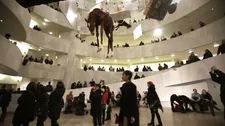 |
| Maurizio Cattelan's All: "And when I heard what he was doing at the Guggenheim, I thought that's an incredible story." |
In 1989, Maurizio Cattelan put up a note stating Torno Subito (Be Right Back) outside a Milan gallery. The gallery held no artworks and the promise to return was left unfulfilled. Art as absence. Axelrod's compelling documentary, referencing the title of the piece in her own title, contains plenty of artworks and masterfully arranges them around an almost imperceptible central void.
To rediscover or discover Cattelan this way is a pleasure and commentary by the artist's sister, ex-girlfirend, current girlfriend, gallerists, collectors and many more makes for a curious, uncanny experience. An invisible Do Not Disturb sign has become the omnipresent guidepost in our world today as technology is taken from the private into the public space. Cattelan's work has been a continuous antiserum to the numbness produced by this fact.
Maurizio Cattelan: Be Right Back had its World Premiere at the Guggenheim Museum as a Special Event during last year's Tribeca Film Festival.
Just before our conversation began, Maura received a phone call.
Anne-Katrin Titze: That call just now was from Maurizio?
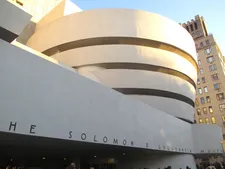 |
| Maurizio Cattelan's retrospective All was a hit at the Guggenheim Museum Photo: Anne-Katrin Titze |
Maura Axelrod: Yes. And he never calls on the telephone. It's always FaceTime.
AKT: Did anything change in your film since it premiered last year at Tribeca?
MA: We added some more music and we tightened it up. Did you see it in Tribeca?
AKT: Yes, I saw it there last year.
MA: Cool. We just cut fat a little bit. When we were finishing it for Tribeca it was in a big rush - as it always is. So we went back and tried to make it a little smoother in places. The only thing that we added was at the very end. Of course, Maurizio has come back from retirement, so we added a graphic at the end that showed the golden toilet and the fact that he was back at it. That he has returned from his retirement.
AKT: While I was sitting here waiting for you, I thought about his motto to always send somebody else…
MA: I just don't have anyone that…
AKT: … could do you?
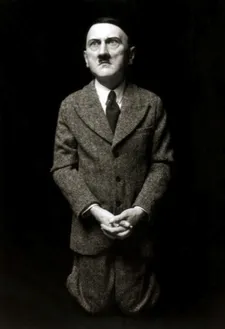 |
| Maurizio Cattelan's HIM is seen in Agnès Varda's film Ydessa, The Bears And Etc. |
MA: I don't mind doing interviews but I always thought of sending someone in my place; how that would be.
AKT: It is a nice thought and an escape in a way.
MA: It is, because then you're not responsible for what is said.
AKT: Do you know Gianfranco Rosi? He was nominated for an Oscar for Fire at Sea this year.
MA: Yeah. Did he send someone in his place?
AKT: No, but the first time I met him, [for Sacro GRA] he was talking to his friend, the jewelry designer John Hardy, at the Film Society of Lincoln Center. Then Gianfranco suggested I do the interview with his friend instead. In the feature I called it our Maurizio Cattelan moment.
MA: That's so funny.
AKT: I thought why not? It would be interesting to interview somebody's friend as them.
MA: It might even be more revealing.
AKT: That's why we don't do it. Tell me a little bit how it all began.
MA: I knew Maurizio for years and years. I had met him when he was installing a Christie's piece and I was working in news. He was installing the Pope piece in Christie's in 2001. I did a story about that because it was a controversial piece for ABC News. And I met him there and was trying to get to do an interview, you know, the whole nine yards. And we became friends and we stayed friends all those years. And when I heard what he was doing at the Guggenheim, I thought that's an incredible story.
AKT: That was 2011?
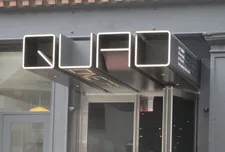 |
| Quad Cinema in New York Photo: Anne-Katrin Titze |
MA: That was five years ago and I said, we have to capture that. We have to figure out a way to do a project. I suggested to him that we do something small. But I knew he was a big enough personality and his work was important enough that it could be a feature film. So I always had that in mind but I suggested to him slowly in stages and just let it get bigger and bigger over the years.
AKT: How did the "getting bigger" work? By focusing on the history? On certain artworks?
MA: In terms of getting him on camera or getting any sort of live stuff with him or what he was doing with the work - I just had to take what I could get. When the work was on display I would go and film it. I knew that I wanted to do a document of the work itself.
AKT: Which hasn't been done like that?
MA: No, not really. I wanted to show his progression as an artist because I think it's cool and important. So that's where I started and then I wanted to fill it in with other information and try and learn something about him. Which, of course, we never do, but I tried to make it a bigger story by bringing in more about him and his personal life as much as I could.
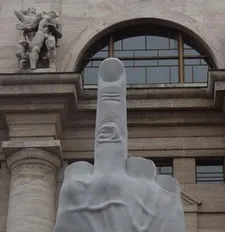 |
| Maurizio Cattelan's L.O.V.E at Milan's stock exchange: "I mean, people are always asking for it." |
AKT: The result is that when we see the personal life, we have to take it with a grain of salt. I don't know how much I can trust what I see. Are these girlfriends actual girlfriends, or actresses?
MA: They're not. They are real. And they are both named Victoria.
AKT: It's quite amazing that they both agreed to be on camera.
MA: I was amazed. I mean, he encouraged a number of people to just go ahead and talk to me.
AKT: The kneeling Hitler boy art work [HIM] is part of Agnès Varda's film Ydessa, the Bears and etc. at the Haus der Kunst in Munich, isn't it?
MA: Exactly. And they know each other. I know she has seen the film. And it is that piece.
AKT: Somebody in your film says "People are complicit in their own abuse.'"
MA: Yeah. Do you think that's true?
AKT: I think so, to a certain degree.
MA: What she, the director of the Cattelan Archive, Victoria Armutt, means, I think, is the people who get abused by his work. Like Massimo de Carlo gets taped up to the wall. I don't know if it rises to the level of abuse really. Abuse is a funny way to put it because he makes fun and he teases but he doesn't actually harm people. But people do sign up. The Milan city council signed up for a Cattelan piece in front of the stock exchange. And there it was [L.O.V.E - a big middle finger]. I mean, people are always asking for it.
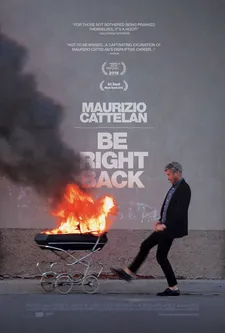 |
| Maurizio Cattelan: Be Right Back poster |
AKT: Be Right Back you chose as the title, a piece from 1989.
MA: He actually chose the title. I thought it was one of his most iconic works and where it all began. Maybe the first moment that style worked for him and he kept going. I also thought it was to signal the audience that there's some kind of absence at the heart of the movie. Like he's left and someone else sat down in his place, kind of.
AKT: It's a lot about time, too, because what is "right back?"
MA: That's a good point.
AKT: It's about identity in time. If you don't invest the time, it's not going to work. The Pinocchio piece I also find fascinating.
MA: Me too. It's funny because I've got asked a lot what I think that piece means and he gets asked that all the time. I don't have an answer. It's different things to different people - whether it's funny or tragic, suicide or murder or it's Jesus. There was one interpretation. We interviewed a collector in Europe who owned that piece. He is not in the movie. His interpretation was that it's a Disney figure and it represented the failure of America to use its power for good. Here's this advertising Disney figure that murdered itself. It represents America destroying its own culture.
AKT: To be read together with Father, Father Why Hast Thou Forsaken Me?
MA: It's Daddy, Daddy. It's definitely a religious reference. The sacrifice of the son. The father killed the son to save himself and to save the world.
AKT: It's a wooden boy, of course. Like the wooden cross. Today is Maundy Thursday, how fitting to have this conversation - with the foot washing. Michelangelo Frammartino did Alberi, a film installation at the MoMA PS1 VW Dome for Tribeca a few years back. His producer told me about an upcoming Pinocchio project of his. It's Pinocchio in reverse. He wants to turn back into a tree.
MA: Oh, that's good! I love that. Never mind, I don't want to be a boy anymore!
 |
| 18-karat gold toilet installed in New York's Guggenheim Museum public bathroom for America |
AKT: Yes, I'm done with humanity, let me get back to being a tree. Suicide is a big topic in the film and his work. His sister is going really far with what she exposes.
MA: When you have these moments, it's very emotional work. The pieces themselves are very emotional. I wanted it to be a movie for a general audience who hadn't necessarily heard of him. A lot of art films are for people who already know the artist or they're in the art world. I wanted people who don't know art necessarily to understand that there's more to this work. That moment when his sister talks about her experience with him and that piece.
AKT: The piece with the squirrel and the gun [Bidibidobidiboo]?
MA: Yeah, that was so moving and important. In a way, people say, it redeems him. It's very emotional stuff.
AKT: And on the other hand, you have the total opposite, such as the 6th Caribbean Biennal which is so wonderfully on the spot. Only a party, only the artists having fun, no artworks in sight. High and low - is that how your interacting with him goes as well?
MA: Yes, actually, now that you say that. That's funny. Maybe that's true of everyone, but yeah. That's an interesting way to think of it. He presents that kind of funny, goofy, jumping around persona to the world but he's also a very serious person. A person who thinks a lot and feels a lot. That weird juxtaposition is present in all of his interactions.
 |
| La Nona Ora - Maurizio Cattelan |
AKT: Any new work, anything post the gold toilet at the Guggenheim bathroom that you know he is working on?
MA: The thing about his work is that it gets made elsewhere and it just appears as if it were always there. You don't see any of the craft in it. It's made by someone else. It appears as though from nowhere. I didn't want to take that magic away by watching somebody make any of the works. You know, Gerhard Richter, you see him making a thing. There is some stuff [with Cattelan] where you can see people doing the taxidermy but I specifically wanted the works to just appear as they do in the world.
AKT: That fits with the religious component we just talked about. I never thought about it that way. It's there from the big invisible creator.
MA: That's true. I haven't thought about it either.
AKT: Here - on the first day, I created this and this! Of course, you don't show: How do I make a squirrel?
MA: That's so funny. That's true. I always have to say this - when you make a documentary, it's your editor who should also get a director credit. Our editor Lyman Smith is a genius and he is the reason that the movie got made and was really my co-creator. He came up with a lot of the ideas and he implemented them.
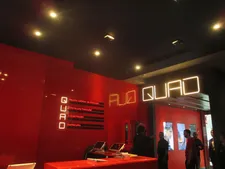 |
| Quad Cinema lobby on the opening week Photo: Anne-Katrin Titze |
AKT: The person who performed Maurizio Cattelan for eight years - it's interesting, the point in the film you get to this. How did you make that decision?
MA: We worked for six months trying to figure out how to make that work in the best way possible.
AKT: Positioning clues, pebbles to help us find our way?
MA: Yes, it was very meticulous work and it took ages to figure it out. We tested it on a million people.
AKT: It's beautifully done. Even for someone familiar with what he looks like, you still managed to get me into this hovering state. It creates doubt where there shouldn't be doubt and it works for people who don't know his work at all.
MA: Thank you. I'm so happy that we seem to have pulled it off. One of the most interesting responses we got from people who didn't know, was that they felt a sense of loss. Because they got attached to Massimiliano as Maurizio and suddenly that's taken away. It was a little bit painful and it pissed them off. Not because they were tricked but because they felt something was gone.
AKT: Which makes it an art piece in itself on truth and trust.
MA: Yeah, I couldn't use my normal practices as a journalist. That's kind of a trick Maurizio played on me. I spent all this time saying "Let's figure you out and put you up on the big screen!" He resisted that and the way I had to solve the problem was basically by essentially lying to the audience, which is what a journalist never does.
AKT: What you said earlier, that you can only talk to him on the phone when he sees your face and he shows his face also? That's the effect of what he is doing. You can't pretend that way to be somebody else.
MA: That's interesting. That's exactly right.
We then walked over to the Quad Cinema for Maura's tech appointment where they were busy preparing for Mayor Bill de Blasio's ribbon cutting ceremony.
Maurizio Cattelan: Be Right Back is screening at the Quad Cinema in New York.





















